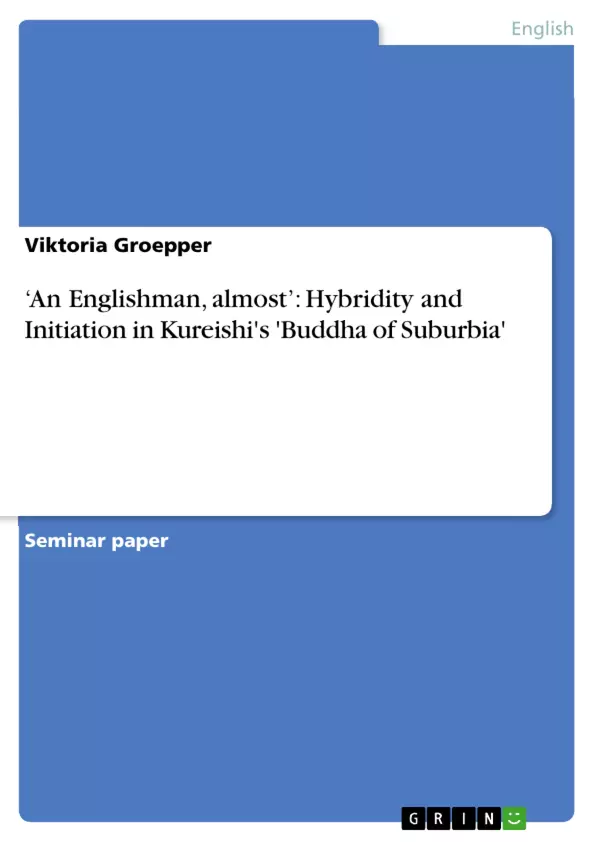“My name is Karim Amir, and I am an Englishman born and bred, almost. I am often considered to be a funny kind of Englishman, a new breed as it were, having emerged from two old histories. But I don’t care – Englishman I am (though not proud of it), from the South London suburbs and going somewhere. Perhaps it is the odd mixture of continents and blood, of here and there, of belonging and not, that makes me restless and easily bored. Or perhaps it was being brought up in the suburbs that did it. [...] I was looking for trouble, any kind of movement, action and sexual interest I could find, because things were so gloomy, so slow and heavy [...] it was all getting me down and I was ready for anything.” (The Buddha 3)
The first lines of Kureishi’s novel reveal most of what this “utterly irreverent, wildly improper but also [...] truthful [...] and very funny” (Salman Rushdie) story will deal with: “initiation, identity, the outsider looking in, and racial conflict. All of these issues are introduced in the first paragraph.” (Kaleta 68) Karim Amir, the son of an Indian father and a white English mother is the protagonist and narrator of the novel The Buddha of Suburbia. First published in 1990, the novel is considered to be Hanif Kureishi’s most successful novel. It combines the two genres “Bildungsroman” and “Condition of England” novel. Both are typical for the 19th century, but Kureishi successfully combines them both and brings them into a contemporary setting. (Bentley 161) The term “Bildungsroman” was coined by the German philologist Johann Morgenstern and arose during the German Enlightenment, presenting the psychological, moral and social shaping of a usually young protagonist...
Table of Contents
- Introduction
- Hybridity and Alienation in The Buddha of Suburbia
- A definition of the term “hybridity”
- Karim as a racial hybrid
- Karim as a social hybrid
- Karim as a sexual hybrid
- Initiation novels
- Introduction
- Karim as an initiate
- Karim's journey
- Initiation in The Adventures of Huckleberry Finn
- Initiation in The Catcher in the Rye
- Comparison
- Conclusion
Objectives and Key Themes
This paper aims to analyze the themes of hybridity and alienation in Hanif Kureishi's novel The Buddha of Suburbia, exploring how the protagonist, Karim Amir, navigates his dual identity as a child of both Indian and British cultures. The paper further examines Kureishi's novel in the context of initiation novels, comparing it with Mark Twain's The Adventures of Huckleberry Finn and J.D. Salinger's The Catcher in the Rye.
- Hybridity and identity formation
- Alienation and belonging
- Initiation and coming-of-age
- Racial and cultural prejudice
- The impact of colonialism on postcolonial societies
Chapter Summaries
The introduction sets the stage for the analysis, introducing the protagonist Karim Amir and his unique identity as a hybrid of Indian and British cultures. The novel is positioned within the context of both the "Bildungsroman" and the "Condition of England" novel, emphasizing its exploration of the social and cultural landscape of 1970s Britain, particularly focusing on issues of racism, cultural clash, and youth culture. The paper then delves into the concept of hybridity, drawing on postcolonial theory and highlighting its complexity in relation to individual and national identity.
The chapter on Karim as a racial hybrid examines his experiences with prejudice and his struggle to define his place within British society, despite his strong sense of English identity. The chapter explores how Karim’s racial identity shapes his experiences and his relationship with both Indian and British cultures.
The chapter exploring Karim as a social hybrid dives into the complexities of his social integration, analyzing his social interactions and his experiences with different social groups. This chapter explores the challenges and opportunities that arise from being a hybrid figure within a society that often struggles to accommodate diverse identities.
Keywords
The key terms explored in this paper include: hybridity, alienation, initiation, postcolonialism, Bildungsroman, Condition of England novel, racism, cultural clash, youth culture, and identity.
- Quote paper
- Viktoria Groepper (Author), 2009, ‘An Englishman, almost’: Hybridity and Initiation in Kureishi's 'Buddha of Suburbia', Munich, GRIN Verlag, https://www.grin.com/document/151586



